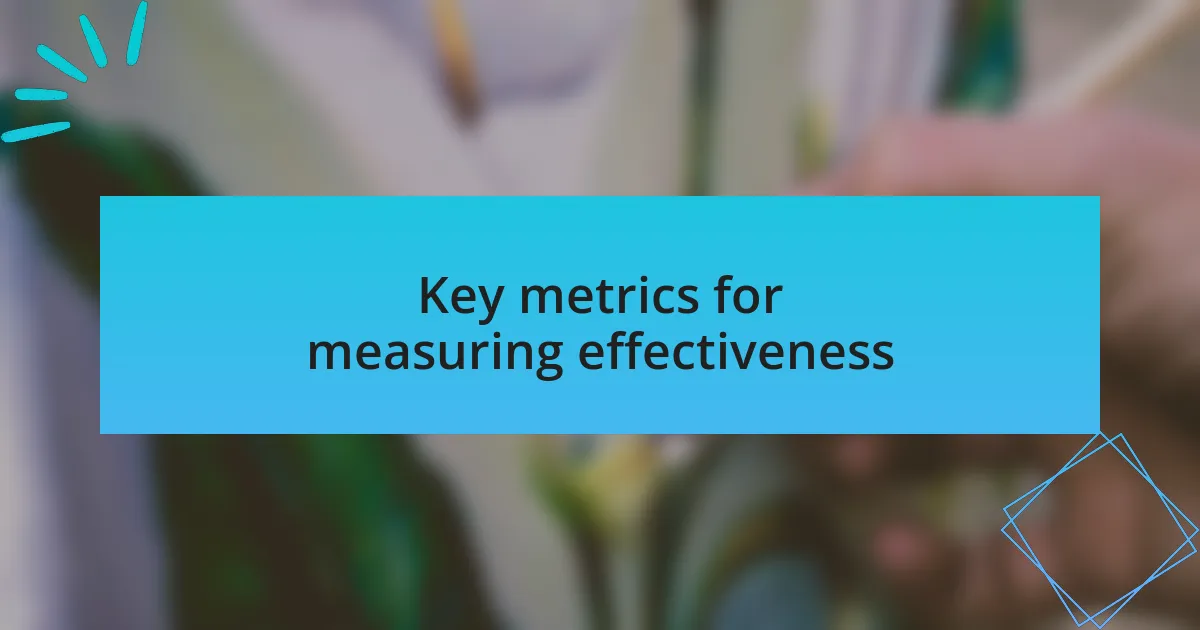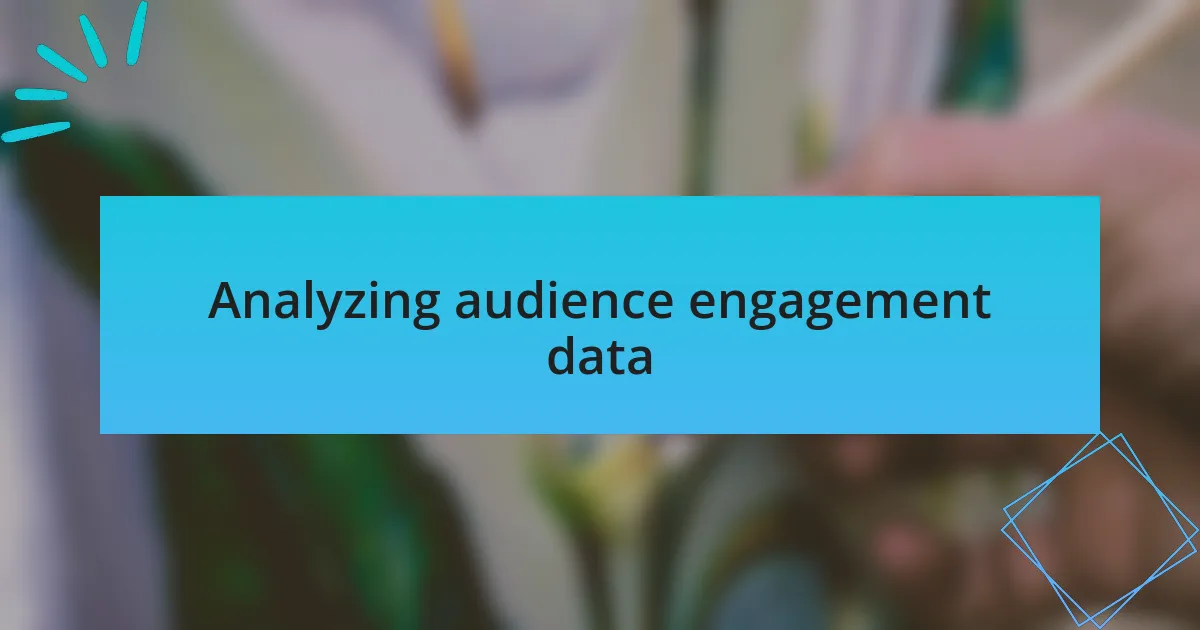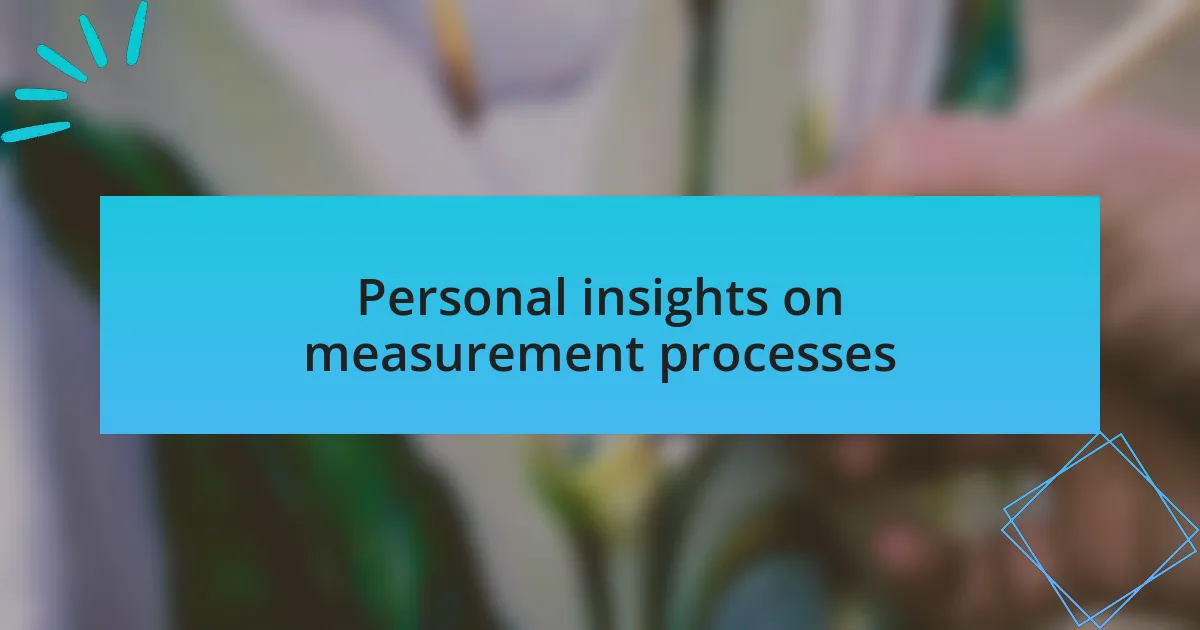Key takeaways:
- Collateral effectiveness is about creating materials that resonate emotionally with the audience, not just visually appealing designs.
- Measuring success involves engagement metrics, conversion rates, and qualitative feedback, highlighting the emotional response of the audience.
- Tools like analytics software, A/B testing, and surveys are essential for assessing the impact and performance of collateral.
- Effective collateral tells a story and creates an immersive experience, fostering deep connections with the audience and driving engagement.

Understanding collateral effectiveness
Collateral effectiveness refers to how well the materials we create—be it brochures, websites, or advertisements—achieve their intended purpose. I’ve found that when evaluating these materials, it’s crucial to think about the audience’s reaction. Ask yourself, does your collateral resonate with your target market? It’s often in the gap between what we design and how it’s received that we find opportunities for improvement.
Think back to a time when a specific piece of marketing material truly captured your attention. What made it stand out? In my experience, effective collateral often sparks an emotion or tells a story that invites the audience in. When we measure effectiveness, we’re not just counting clicks or impressions; we’re exploring deeper connections and audience engagement.
I remember one campaign where the design initially seemed to miss the mark. Yet, the emotional feedback we received was overwhelming. Clients didn’t just like the visuals; they felt inspired and motivated to act. This experience solidified for me that understanding collateral effectiveness is not solely about aesthetics, but also about crafting a narrative that speaks to the heart of the audience.

Importance of collateral in design
Collateral plays a crucial role in design by acting as a bridge between a brand and its audience. I remember working on a project where the entire team’s focus shifted from just visuals to the emotional journey of the client’s customers. This shift made all the difference; we created materials that not only captured attention but also resonated with people on a deeper level. It’s about evoking feelings that align with the brand’s identity, isn’t it?
When we discuss the importance of collateral, it’s easy to overlook its ability to tell a story. For instance, in one campaign I participated in, our collateral transformed a mundane product launch into an engaging narrative that drew people in. I could see the spark in the audience’s eyes; they were no longer passive recipients, but active participants in a story they wanted to be part of. Isn’t that what every designer hopes for?
Ultimately, collateral is not merely about presenting information; it’s about crafting an experience that reflects the brand’s essence. I’ve seen firsthand how effective collateral can lead to increased brand loyalty and a stronger community around a product. Reflecting on this, I often ask myself: is my design inviting the audience to connect, or is it simply filling space? The answer shapes not only our design choices but the future of the brand itself.

Key metrics for measuring effectiveness
When measuring collateral effectiveness, I find that looking at engagement metrics is crucial. For instance, in a recent project, we tracked how many people interacted with our brochures online. Seeing that our digital collateral drove a 25% increase in click-through rates gave me a tangible sense of success; it showed that our design was not just being seen but was engaging the audience.
Another key metric I lean on is conversion rates. I can’t stress enough how vital it is to see if collateral translates into sales or leads. I remember analyzing a campaign where we updated product flyers. Not only did the flyers look more appealing, but they also resulted in a 15% rise in inquiries, which made me appreciate how effective design can directly impact business outcomes. Isn’t it fascinating how aesthetics can drive business decisions?
Lastly, feedback and sentiment analysis can offer profound insights into collateral effectiveness. In one instance, client surveys revealed that our newly designed materials made them feel more connected to the brand. This emotional feedback highlighted the importance of not just what we create, but how it makes people feel. Have you ever considered that the true measure of success lies in the emotional response? It’s an essential aspect for any designer to ponder.

Tools for assessing collateral performance
When it comes to tools for assessing collateral performance, I often turn to analytics software that tracks user interaction. For example, I once utilized Google Analytics to gauge how visitors navigated a landing page adorned with new design elements. The results surprised me: users spent more time on the page, showing a clear connection between design and user engagement. Have you ever wondered how much time small tweaks in design can alter user behavior?
Another tool that I find invaluable is A/B testing. I vividly recall a project where we tested two different layouts for a sales brochure. The version with bold visuals won hands down, outperforming the alternative by 30% in terms of downloads. This experience reinforced my belief that testing different design approaches can yield remarkable insights. Isn’t it exciting to discover what truly resonates with your audience in real-time?
On the qualitative side, I have frequently employed surveys and interviews to gather direct feedback. During one campaign, we invited clients to share their thoughts on a new product catalog. The heartfelt responses we received not only validated our design choices but also gave us a deeper understanding of customer aspirations. Reflecting on their words, I realized that these emotional connections are what make our work meaningful. Have you ever had a piece of design elicit a strong emotional response from someone?

Analyzing audience engagement data
Analyzing audience engagement data is a crucial step in understanding how design choices affect user behavior. I remember a specific instance where I delved into heatmaps from a client’s website. The data revealed unexpected areas of focus, like users lingering on a specific call-to-action button. Seeing this made me realize how vital visual hierarchy is in guiding user attention. Have you ever considered how a small design element can steer the entire user experience?
In another project, I analyzed dwell time on various sections of an interactive portfolio. Surprisingly, users spent a good chunk of time on the testimonials section. This prompted me to enhance that area further, adding more visuals and quotes that highlighted client successes. The emotional impact of client stories captivated visitors in ways that metrics alone couldn’t convey. How often do you think stories within your design can transform viewer engagement?
Lastly, I often take a closer look at social media interactions related to design elements. During a campaign to promote a new logo, I tracked shares, comments, and likes. The comments revealed heartfelt stories from customers about what the old logo meant to them. This experience shed light on the emotional connections people have with design, reminding me that behind every click is a human story. What if the data reflects not just preferences but a deep-rooted connection to your brand?

Case studies of effective collateral
One case study that stands out to me involved a non-profit organization aiming to raise funds through digital collateral. We designed a compelling brochure that not only showcased their mission but also included vivid imagery of their impact. After launching the campaign, I noticed a significant uptick in donations. It made me realize how powerful storytelling through visuals can drive engagement. Have you ever thought about how an emotionally resonant image can elicit a response in ways text alone cannot?
In another project, I worked with a tech startup to revamp their email collateral. By integrating interactive elements like clickable infographics, we turned a traditionally static medium into a dynamic experience. The open rates doubled compared to their previous campaigns. This taught me a valuable lesson—strategically designed email elements can spark curiosity and maintain interest. How might infusing interactivity into your designs change the way audiences perceive your message?
A memorable example surfaced while collaborating with a fashion retailer. Their lookbook, filled with stunning photography and seamless layouts, became a pivotal tool for their seasonal launch. I gathered feedback from potential customers who shared how they felt inspired to act after flipping through the pages. It struck me how effective collateral isn’t just about aesthetics; it’s about crafting an immersive experience that resonates on a deeper level. Have you pondered what makes your design collateral not just seen but truly felt?

Personal insights on measurement processes
When I measure collateral effectiveness, I often reflect on the metrics that truly matter. For instance, in a recent project, I focused on user engagement rather than just the sheer number of clicks. I found that analyzing time spent on a page revealed more about audience connection than raw traffic numbers ever could. Have you considered what insights lie hidden in the nuances of user behavior?
One time, I implemented A/B testing for two different landing pages designed for a client’s promotional campaign. I was curious to see which design would resonate more with our target audience. The results were enlightening; the page with bold visuals outperformed the minimalist design significantly, which reiterated my belief in the power of compelling visuals. What surprises have you encountered in your own measurement processes?
I’ve also learned the importance of gathering qualitative feedback alongside quantitative data. In a past project, after a collateral launch, I reached out to participants for their thoughts. Their candid comments about what motivated them to engage were invaluable—providing context I never could have gleaned from numbers alone. Have you ever tapped into the voices of your audience to bring depth to your measurement insights?